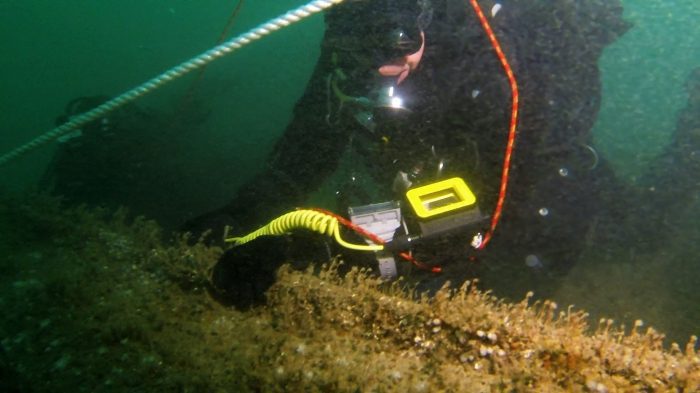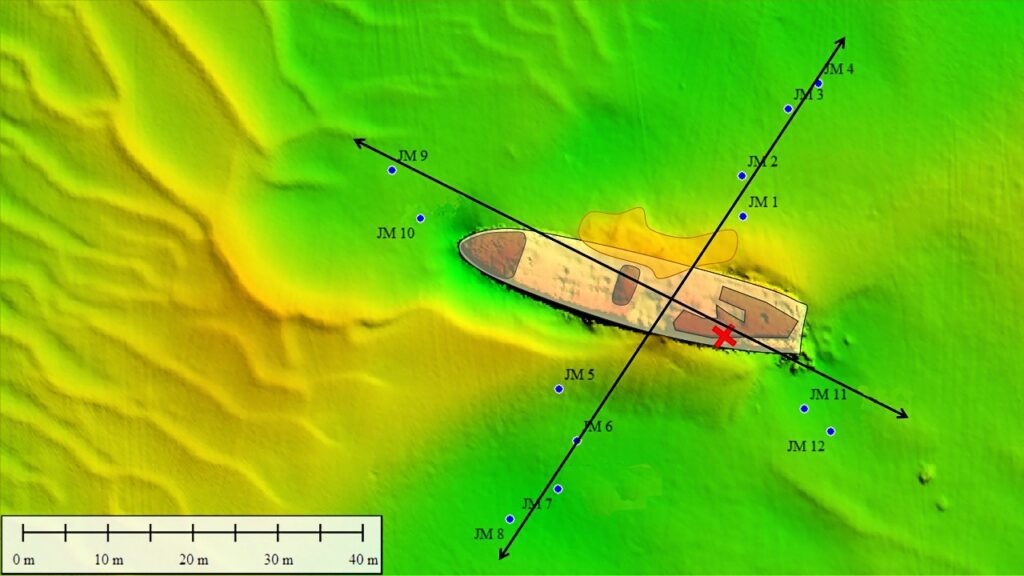A 95-year-old German patrol-boat sunk in the North Sea in World War Two has been shown to be leaking toxic substances and polluting its surroundings – but how typical is the V-1302 John Mahn?
The toxic influence of shipwrecks on the chemistry and microbiology of surrounding sediments remains largely unexplored, say Belgian scientists who recently conducted a deep probe into the wreck, selected because of its relative accessibility.
Built in Hamburg in 1927, the 48m steam-trawler John Mahn was later requisitioned and repurposed by the Kriegsmarine as a Vorpostenboot or VP-boat. On 12 February, 1942 the V-1302 took part in Germany’s Operation Cerberus but was bombed by RAF Hawker Hurricanes after its gunners had downed one of the six aircraft.
The first of two bombs hit V-1302’s funnel and detonated in the boiler-room amidships, with the second hitting the aft section and destroying the propshaft tunnel. The VP-boat began sinking almost at once, taking 11 sailors, its coal reserves and munitions including multiple unexploded depth-charges to the bottom.
Eighty years on the wreck lies “slightly askew” and with its superstructure missing at a maximum depth of 35m in the Belgian North Sea, displaying the large hole in its port side caused by the first bomb.

The scientific team, led by doctorate student Josefien Van Landuyt of the University of Ghent and assisted by the scientific scuba-diving team at Flanders Marine Institute (VLIZ), collected sediment, steel hull and some water samples at increasing distances and in different directions from the wreck.
They then tested the samples for levels of the polycyclic aromatic hydrocarbons (PAHs) that are given off by fossil fuels, explosives and heavy metals.
The PAHs benzanthracene and fluoranthene found were thought to be coming from the ship’s coal-bunker, because the closer the samples taken the higher were the concentrations.
Explosives, arsenic and heavy metals such as nickel and copper were also traced, their presence indicating that the wreck was still affecting surrounding sediments, with toxicity levels depending on the side of the wreck being studied.

According to the scientists the level of microbial analysis made their study unique, extending 15cm deep into surrounding sediments. Microbes known to degrade PAHs such as Rhodobacteraceae and Chromatiaceae were more abundant in those samples with the highest pollution levels, and sulphate-attacking bacteria such as Desulfobulbia involved in steel corrosion were also present.
While the level of pollution caused by the V-1302 John Mahn was found to be insufficiently toxic to discourage fish from using it as a nursery area, the scientists have used it to make a point about the substances remaining on shipwrecks worldwide that could threaten the marine environment.
They reckon that wrecks from the two world wars alone still contain between 2.5 and 20.4 million tonnes of petroleum products and up to 1.6 million tonnes of ammunition.
Pollution by such materials and the leaching of heavy metals affects feeding, growth and reproduction in many marine organisms and can cause irreversible tissue damage, say the scientists.

“While wrecks can function as artificial reefs and have tremendous human story-telling value, we should not forget that they can be dangerous, human-made objects which were unintentionally introduced into a natural environment,” says Van Landuyt. “Today, new shipwrecks are removed for this exact reason.”
She added that on ageing wrecks, corrosion could increase the environmental risk as previously enclosed spaces opened up.
The study, published in Frontiers in Marine Science, is part of the North Sea Wrecks project, which is expected to make recommendations soon on possible removal of certain war wrecks to protect marine life.
Also on Divernet: Mercury Threat From WW2 Wreck, WW2 Wreck Site Was 100 Miles Out, Wreck Diving The Bell Way, RN Divers Extract Large Bomb From London Wreck

